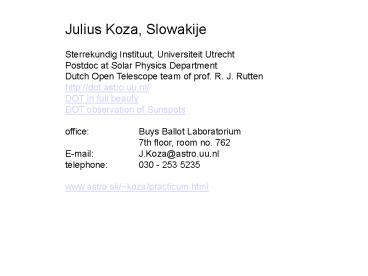The Galilean Moons of Jupiter - PowerPoint PPT Presentation
1 / 13
Title:
The Galilean Moons of Jupiter
Description:
Julius Koza, Slowakije. Sterrekundig Instituut, Universiteit Utrecht. Postdoc at ... Ptolemy described in his book Almagest geocentric system and gave various ... – PowerPoint PPT presentation
Number of Views:63
Avg rating:3.0/5.0
Title: The Galilean Moons of Jupiter
1
Julius Koza, Slowakije Sterrekundig Instituut,
Universiteit Utrecht Postdoc at Solar Physics
Department Dutch Open Telescope team of prof. R.
J. Rutten http//dot.astro.uu.nl/ DOT in full
beauty DOT observation of Sunspots
office Buys Ballot Laboratorium
7th floor, room no. 762 E-mail J.Koza_at_astro.u
u.nl telephone 030 - 253 5235
www.astro.sk/koza/practicum.html
2
The Galilean Moons of Jupiter
- Astronomical Practicum, January 22 - 26, 2007
3
Origin of the word planet
- the ancients knew just seven planets including
the (Sun, Moon), Mercury, Venus, Mars, Jupiter,
and Saturn - planets (from Greek) mean wanderers implying
their apparent drift among fixed stars
4
History and founders of celestial mechanics
celestial mechanics - the branch of astronomy
concerned with the application of Newtons laws
of motion to the motions of heavenly bodies
"If I have seen further (than you and Descartes)
it is by standing upon the shoulders of Giants."
I.
Newton in a letter to Robert Hooke, February 5,
1676
Isaac Newton (1643-1727)
Galileo Galilei (1564-1642)
Johannes Kepler (1571-1630)
Tycho Brahe (1546-1601)
Nicolaus Copernicus (1473-1543)
Claudius Ptolemay (100 - 170 AD)
5
Mysterious planetary kinks
6
Claudius Ptolemy (100 AD - 170 AD)
- synthesized and extended Hipparchus's system of
epicycles and eccentric circles to explain his
geocentric theory of the solar system. - Ptolemy's system involved at least 80 epicycles
to explain the motions of the Sun, the Moon, and
the five planets known in his time. - He believed the planets and sun to orbit the
Earth in the order - Moon, Mercury, Venus, Sun, Mars, Jupiter,
Saturn. - This geocentric system predicted the positions of
the planets accurately enough for naked-eye
observations.
7
Ptolemys epicycles, deferents and excenters
Ptolemy described in his book Almagest geocentric
system and gave various arguments to prove that,
in its position at the center of the universe,
the Earth must be immovable.
8
Nicolaus Copernicus (1473-1543)
- replaced the geocentric universe of Ptolemy with
one that was centered on the Sun, with only the
Moon orbiting the Earth - his heliocentric system was quite
contra-intuitive - the explanation for retrograde motion in this
system - planets move in circular orbits
- the planets further from the sun are moving more
slowly than those closer to the sun (decreasing
orbital velocity with the distance) - De revolutionibus orbium coelestium, libri VI (On
the Revolutions of the Heavenly Spheres, six
books published in 1543)
9
The problems of Copernican heliocentrizm
- Objections against heliocentrizm known from
antique
- If the Earth actually spun on an axis (as
required in a heliocentric system to explain the
diurnal motion of the sky), why didn't objects
fly off the spinning Earth ? - If the Earth was in motion around the sun, why
didn't it leave behind the birds flying in the
air ? - If the Earth were actually on an orbit around the
sun, why wasn't a parallax effect observed ?
- Moreover, Copernican heliocentric system
- was no more precise in predicting of planetary
motion than Ptolemy's model - also needed the eccentrics, epicycles, and
equants of Ptolemaic cosmology - but mathematically simpler and more elegant
10
Johannes Kepler (1571-1630)
- aimed at finding the lows of planetary motions
able to explain the best observations available
at those times - Tycho Brahe (1546-1601)- the best naked eye
observer of pre-telescopic era - laborious and obsessed Kepler inherited large
archive of Tychos observations of the postions
of the planets - after twenty years of painstaking trial-and-error
attempts at making some sense out of the data he
finally arrived at his three laws of planetary
motion subsequently published in two books
Astronomia Nova (New Astronomy, 1609) - first
and second law - Harmonices Mundi (The Harmonies of the World,
1619) - third law - using these laws Kepler was able to predict the
planetary motion with unprecedented precision and
in perfect agreement with observations
The statue of Brahe and Kepler in Prague
11
Keplers laws of planetary motion
- Keplers laws are empirical laws, it means they
were found from an analyze of observations. - Kepler's elliptical orbit law
- 1. Each planet moves in an elliptical orbit, with
the sun at one focus of the ellipse. - Kepler's equal-area law
- 2. A line from the sun to a given planet sweeps
out equal areas in equal times. - Kepler's law of periods
- 3. The periods of the planets are proportional to
the 3/2 powers of the semi major axis lengths of
the orbits.
- Kepler was first man in the world knowing the
right answer on the question - HOW THE PLANETS MOVE ?
- But he still couldnt answer WHY is it so.
12
Two different periods !
- The synodic period Tsyn the period with respect
to the Sun - The sidereal period Tsid the revolution period
with respect to the stars - Always holds Tsyn gt Tsid
- Periods of the Moon
- Synodic month (new moon to new moon) 29.53 days
- Sidereal month (fixed star to fixed star) 27.32
days
Third Keplers law tells about sidereal period T
!!!
13
Declination ? what is it ?
- Declination ? is the angular distance to a point
on a celestial sphere measured north or south
from the celestial equator in degrees.































